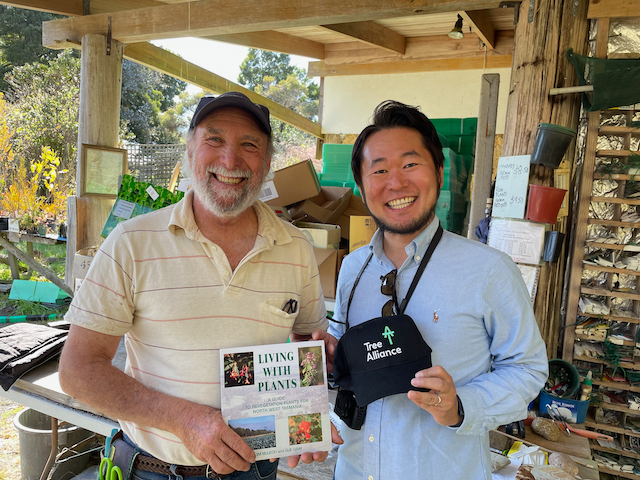20-Oct-2023 | Oldina Nursery & Forico Nursery in Tasmania
- Kazuki KAGOHASHI
- Jun 22, 2024
- 2 min read
On October 20, 2023, we visited two impressive local nurseries—Oldina Nursery and Forico Nursery. My good friend Molly Marshall and her husband Andy guided us on this tour. Oldina Nursery is run by a professional native plant grower, Jim McLeod, and has provided various indigenous seedlings upon request from Landcare groups and people. There were unique Tasmanian Rainforest plants, local North West shrubs, bush trees (e.g., Kunzea ambigua), wildflowers (e.g., Micromyrtus ciliata alba) and eucalyptus trees such as Eucalyptus cinerea. The nursery was tidy but had a huge variety of local plant seedlings. Jim guided us around and gave me a copy of his beautiful book Living with Plants: A Guide to Revegetation Plants for North west Tasmania (co-authored by Sue Gray, published in 2005).

Figure 1. Oldina Nursery. It was a "hotspot" of the diversity of native seedlings.

Figure 2. Snapshot with Jim McLeod (left) and me (right).

Figure 3. The seedlings from Oldina Nursery are provided to local Landcare groups. This photo was taken at a project site at Freestone Cove, which was done by the Wynyard Landcare group to alleviate the erosion in the coastal area.
After leaving Oldina Nursery, we then headed to a nursery run by a company, Forico. According to their website, Forico is the largest forest manager by private company in Tasmania, which approximately manages more than 170,000 ha. Forico has met the certificate FSC and The Responsible Wood Chain of Custody (CoC) Standards and published the "Natural Capital Report" every year.
Forico Nursery also breeds native seedlings with productive facilities. They grew four types of seedlings (such as Radiata Pine, Eucalyptus globulus (Tasmanian blue gum), etc.). The nursery area was very large, and the germination procedure through packaging was managed efficiently. It was just after the busiest time, but we could learn about their highly competitive nursery system.

Figure 4. Forico's nursery system was highly efficient and could produce large amounts of seedlings in one season.

Figure 5. Grown seedlings ready for sale. Some seedlings are difficult to manage as they sometimes overgrow due to climate conditions. Overgrown seedlings cannot be provided to customers. (Left: Mr. Scipio Luttmer, the manager of the nursery)
It was fortunate for me to visit these two different nurseries. Both nurseries are highly professional but in different ways. Oldina Nursery was a small-scale and less capital-intensive nursery that provided highly diverse seedlings according to the needs of local people and groups. On the other hand, Forico Nursery was a large-scale and highly capital-intensive nursery (e.g., watering, electricity, metal trays, packaging machine, etc.) that could produce large amounts of limited variety of seedlings. Don't take me wrong; that doesn't mean which is better or worse. Both nurseries are equally critical to delivering native seedlings across the state. Some Landcare groups may need rare types of Indigenous plants to attract certain insects or birds, while others need large amounts of but a specific type of trees for a large-scale revegetation project.
I would like to add the importance of knowledge accumulated in each nursery. It should not be an exaggeration to say that local knowledge of growing and producing native seedlings plays a key role in both nurseries. Local knowledge should be counted as a component of a region's "wealth" in addition to its "natural capital" asset.
Comments